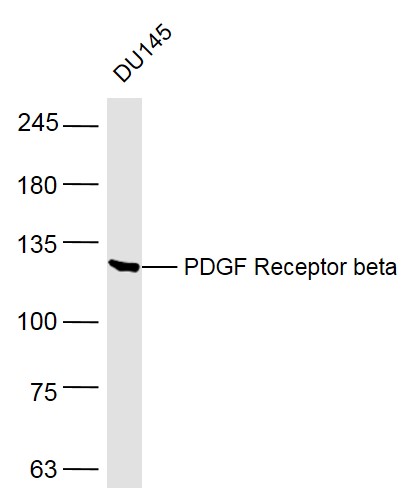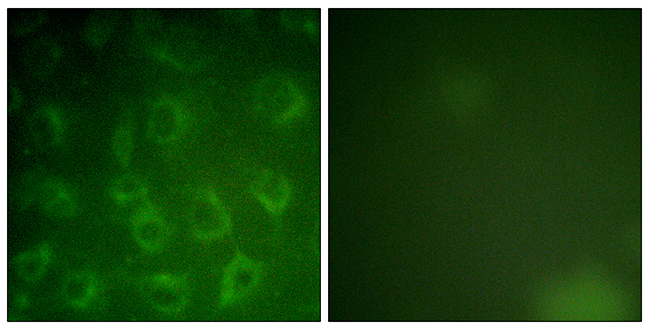
Immunohistochemical staining of formalin fixed and paraffin embedded human kidney tissue section using anti-CD140b rabbit monoclonal antibody (Clone RM303) at a 1:200 dilution.
anti-CD140b (C-term) (human), Rabbit Monoclonal (RM303)
REV-31-1188-00
ApplicationsWestern Blot, ImmunoHistoChemistry
Product group Antibodies
ReactivityHuman
TargetPDGFRB
Overview
- SupplierRevMAb Biosciences
- Product Nameanti-CD140b (C-term) (human), Rabbit Monoclonal (RM303)
- Delivery Days Customer10
- ApplicationsWestern Blot, ImmunoHistoChemistry
- CertificationResearch Use Only
- ClonalityMonoclonal
- Clone IDRM303
- Gene ID5159
- Target namePDGFRB
- Target descriptionplatelet derived growth factor receptor beta
- Target synonymsCD140B, IBGC4, IMF1, JTK12, KOGS, OPDKD, PDGFR, PDGFR-1, PDGFR1, PENTT, platelet-derived growth factor receptor beta, Activated tyrosine kinase PDGFRB, CD140 antigen-like family member B, NDEL1-PDGFRB, PDGF-R-beta, PDGFR-beta, beta-type platelet-derived growth factor receptor, platelet-derived growth factor receptor 1, platelet-derived growth factor receptor, beta polypeptide
- HostRabbit
- IsotypeIgG
- Protein IDP09619
- Protein NamePlatelet-derived growth factor receptor beta
- Scientific DescriptionCD140b (PDGFRbeta) is a typical receptor tyrosine kinase, which belongs to the type III tyrosine kinase receptor (RTK) family and is structurally characterized by five extracellular immunoglobulin-like domains, a single membrane-spanning helix domain, an intracellular juxtamembrane domain, a split tyrosine kinase domain and a carboxylic tail. CD140b is a cell surface receptor for members of the platelet-derived growth factor family. These growth factors are mitogens for cells of mesenchymal origin. The identity of the growth factor bound to a receptor monomer determines whether the functional receptor is a homodimer or a heterodimer, composed of both platelet-derived growth factor receptor alpha and beta polypeptides. The gene is flanked by the genes for granulocyte-macrophage colony-stimulating factor and Colony stimulating factor 1 receptor (also termed macrophage-colony stimulating factor receptor), all three of which may be lost together by a single deletional mutation thereby causing development of the 5q-syndrome. Other genetic abnormalities in PDGFRB lead to various forms of potentially malignant bone marrow disorders: small deletions in and chromosome translocations causing fusions between PDGFRB and any one of at least 30 genes can cause Myeloproliferative neoplasms that commonly involve eosinophilia, eosinophil-induced organ injury, and possible progression to aggressive leukemia - Recombinant Antibody. This antibody reacts to human CD140b (PDGFR-beta) (Platelet-derived growth factor receptor beta). Applications: WB, IHC. Source: Rabbit. Liquid. 50% Glycerol/PBS with 1% BSA and 0.09% sodium azide. CD140b (PDGFRbeta) is a typical receptor tyrosine kinase, which belongs to the type III tyrosine kinase receptor (RTK) family and is structurally characterized by five extracellular immunoglobulin-like domains, a single membrane-spanning helix domain, an intracellular juxtamembrane domain, a split tyrosine kinase domain and a carboxylic tail. CD140b is a cell surface receptor for members of the platelet-derived growth factor family. These growth factors are mitogens for cells of mesenchymal origin. The identity of the growth factor bound to a receptor monomer determines whether the functional receptor is a homodimer or a heterodimer, composed of both platelet-derived growth factor receptor alpha and beta polypeptides. The gene is flanked by the genes for granulocyte-macrophage colony-stimulating factor and Colony stimulating factor 1 receptor (also termed macrophage-colony stimulating factor receptor), all three of which may be lost together by a single deletional mutation thereby causing development of the 5q-syndrome. Other genetic abnormalities in PDGFRB lead to various forms of potentially malignant bone marrow disorders: small deletions in and chromosome translocations causing fusions between PDGFRB and any one of at least 30 genes can cause Myeloproliferative neoplasms that commonly involve eosinophilia, eosinophil-induced organ injury, and possible progression to aggressive leukemia
- ReactivityHuman
- Storage Instruction-20°C
- UNSPSC12352203





